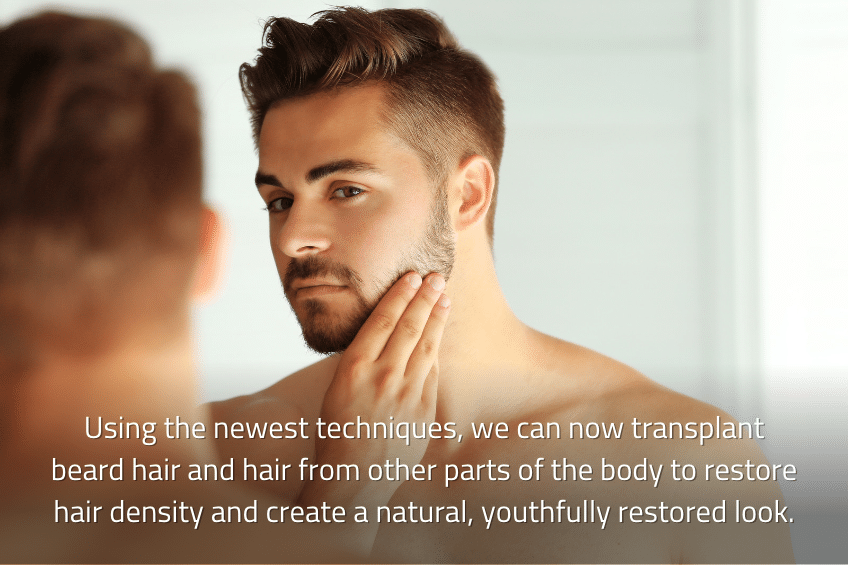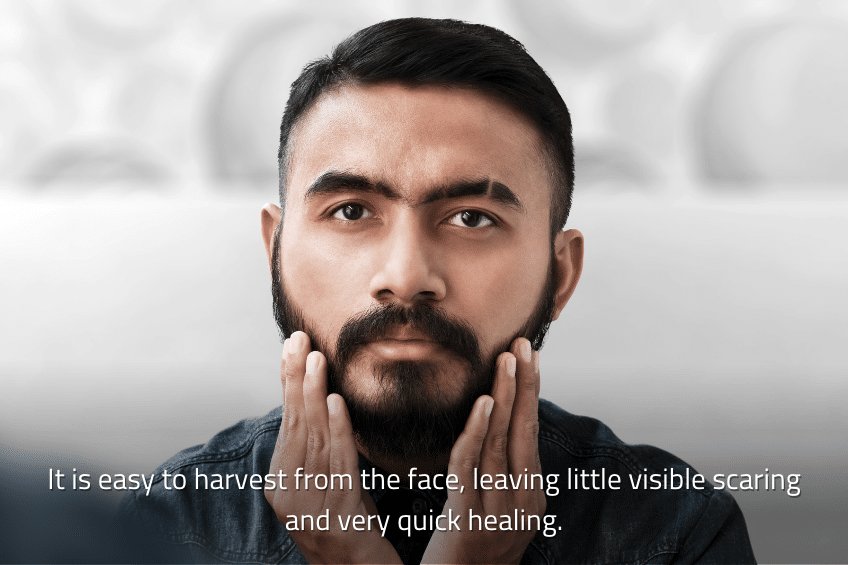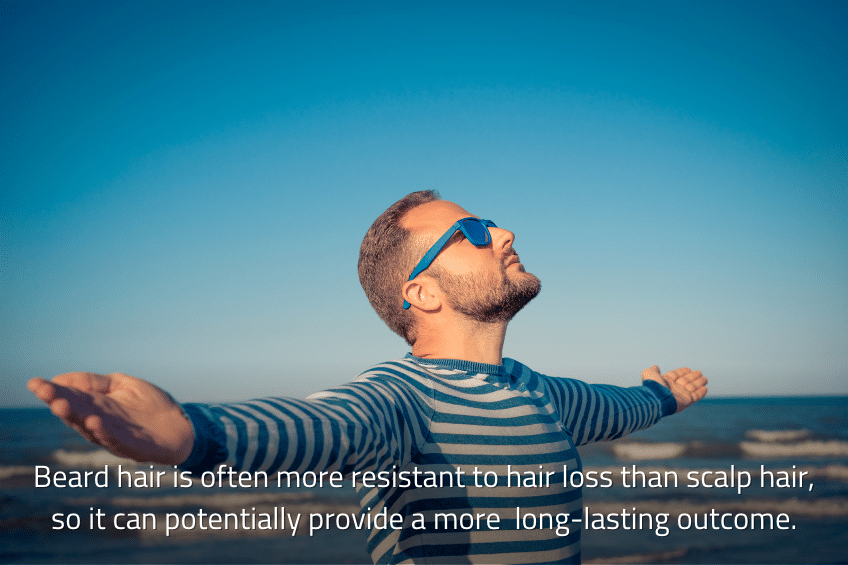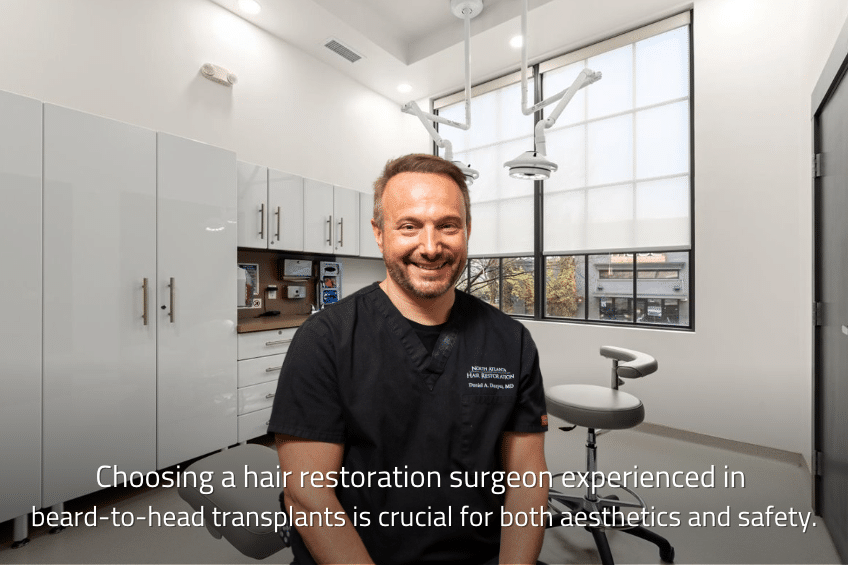A beard to head hair transplant is an outpatient surgical procedure that involves transplanting hair follicles from the beard to the scalp.
This type of hair restoration surgery is typically sought out by those who suffer from such severe baldness that donor sites on the head are not adequate.
It is also a common treatment for patients who have had previous hair transplants that depleted good donor sites on the scalp.
Beard hair transplants can be used to correct hair loss caused by genetics, age, hormonal changes, illness or follicular damage from hairstyling.
A beard to head hair transplant can be an excellent alternative for those ineligible for traditional hair transplantation because it offers a unique source of donor hairs.
Unlike scalp donor hair, which some patients may not have enough of, beard grafts can provide an abundant supply of healthy hair.
Dr. Daniel A. Danyo is an expert at beard to head hair transplant procedures, and he has performed countless successful restoration procedures for patients at NAHR.
“Patients with advanced hair loss don’t need to give up the hope of having an attractive, full head of hair. Using the newest techniques, we can now transplant beard hair and hair from other parts of the body to restore hair density and create a natural, youthfully restored look,” says Dr. Daniel A. Danyo.
How Does Beard to Head Hair Transplantation Work?
During transplant surgery, hair grafts are extracted from the beard area, usually using a technique called follicular unit extraction (FUE).
This type of follicular unit hair transplant technique involves removing individual facial hair follicles from the beard area and then transplanting them onto thinning or totally bald areas on the scalp.
It’s important to note that not all beard hair is suitable for transplantation, and hair restoration surgeons must carefully select the right hair follicles to ensure a successful hair transplant.
The beard hairs that are extracted must be healthy and in their growth phase, also known as the anagen phase.
Additionally, the extraction method used must be precise in order to avoid damage to the beard hair follicles, which can negatively impact the success of the transplant.
Moreover, since it is a surgical procedure, there are certain risks, including unsightly scarring, poor follicle viability and even unsightly results.
For this reason, choosing a hair restoration surgeon experienced in beard-to-head transplants is crucial for both aesthetics and safety.
Dr. Daniel A. Danyo is an expert hair transplant surgeon certified through the American and International Board of Hair Restoration Surgery.
He performs every consultation and places every graft himself, aided by his able support team at North Atlanta Hair Restoration.
“Beard hair is an excellent choice for hair transplantation. The thickness of each beard hair is typically twice that of scalp donor hair, which means more than twice the amount of volume placed. It is easy to harvest from the face, leaving little visible scaring and very quick healing.”

The Benefits of a Beard to Head Hair Transplant
The greatest thing about a beard to head hair transplant is that it makes hair restoration possible for those who don’t have enough head hair left for a transplant.
One of the advantages of using beard hair for transplantation is that it tends to be thicker and coarser than scalp hair, so it can provide better coverage for a more natural look.
The thicker hair shafts can also be used to conceal linear scars caused by previous hair transplant surgeries.
Additionally, beard hair is often more resistant to hair loss than scalp hair, so it can potentially provide a more long-lasting outcome.
Want to know more? Listen to Dr. Danyo talk about the use of beard and body hair for transplants by checking out his informative podcast on the topic.

How Common Are Beard to Head Hair Transplants?
The National Library of Medicine reports that in the 2020 Practice Survey among members of the International Society of Hair Restoration Surgery, scalp donor hair was used in 92.5% of cases, beard hair in 7.5% of cases, and chest hair in 2.4% of cases.
So how do you know if a beard to head hair transplant might be right for you?
A consultation with a hair restoration expert will be necessary to know for sure, but first, a little background on the different hair transplant methods available today.
Types of Hair Transplantation Methods
Hair transplants are a popular solution for those experiencing hair loss or thinning hair.
This cosmetic procedure involves transplanting healthy hair follicles from the head or areas of the body to the thinning or balding area.
There are different types of hair transplants available, and each has its own unique benefits and drawbacks.
- Follicular Unit Transplantation (FUT):With FUT, also known as the strip method, donor hair follicles are harvested from an area by removing a strip of skin and hair from the scalp. Individual follicular units are then transplanted to the balding area.
This older, less sophisticated method may leave linear surgical scars on the scalp and is not as common as it once was.
- Follicular Unit Extraction (FUE):In FUE, individual hair follicles are harvested from the back of the scalp — or other areas of the body — using a micro-punch tool. These follicular units are then transplanted onto the thinning or balding area.
This method does not require any stitches and leaves only small, hardly noticeable circular scars.
- Direct Hair Implantation (DHI):With DHI, the tech or surgeon uses a pen-like device to implant each individual hair follicle, one at a time, at a specific angle and direction.
This minimally invasive method allows for a more natural-looking result with a higher density of hair.
- Robotic Hair Transplantation: In this procedure, a robot extracts hair follicles from the donor area and transplants them onto the scalp.
Although this method can offer precision and consistency, many hair restoration physicians and patients prefer the results of a more hands-on approach.
- Beard to Head Hair Transplant: This technique involves using hair follicles harvested from the beard to transplant onto the scalp.
Often used in cases where there is not enough hair in the scalp donor area, it can be performed using cutting edge techniques like FUE and DHI.
- Body Hair Transplants: With body hair transplantation, hair follicles are taken from areas of the body other than the scalp. Donor sites may include chest hair, back hair, leg hair, arm hair or even pubic hair.
While useful when scalp donor areas are not an option, it can be challenging to match the hair type, texture and density to the existing head hair.
Tips for a Successful Beard to Head Transplant Surgery
If you are considering a beard to head transplant surgery, it is important to be prepared both mentally and physically. Here are some key tips for a successful hair restoration procedure:
- Consult With an Experienced Hair Restoration Surgeon First
The first step in preparing for a beard to head transplant surgery is to consult with a qualified hair restoration surgeon.
Dr. Daniel A. Danyo performs all his initial consultations himself, and he will assess your scalp and beard hair to determine if this type of transplant is a viable option for you. He will also explain the procedure in detail and answer any questions you may have.
- Stop Smoking and Drinking
Smoking and drinking can have a negative impact on the success of your surgery. Both can restrict blood flow to the scalp, which can slow down healing and reduce the survival rate of the transplanted hair.
It is usually recommended that you stop smoking and drinking at least two weeks before your surgery.
- Have a Doctor Assess Your Medications and Supplements
Certain supplements and medications may thin the blood, which can increase the risk of bleeding during surgery.
Dr. Danyo will consult with you and your regular doctor to determine when and if you should stop taking certain supplements and medications.
- Get Plenty of Rest
Getting plenty of rest before your surgery can help reduce stress and anxiety, which can have a positive impact on your surgery and healing.
It is important to get at least 8 hours of sleep per night in the days leading up to your surgery.
- Follow Post-Operative Instructions
After your surgery, Dr. Danyo and his team will provide you with detailed post-operative instructions including how and when to wash your hair, when you can resume normal activities, etc.
It is important to follow these post-op instructions carefully to minimize the risk of complications and ensure the best possible hair growth outcome.
By following these five simple preparation tips, you can increase the likelihood of a quick recovery and the restored hair volume you desire.
With proper preparation and aftercare, patients can usually expect to see good final results in 6-8 months, although multiple procedures may be required for those with extensive baldness.

Planning a Beard to Head Hair Restoration Procedure
Before any beard to head hair transplant surgery, careful planning is necessary to ensure optimal results.
Board-certified hair restoration surgeon Dr. Daniel A. Danyo will work closely with you to develop a plan that meets your unique needs and hair restoration goals.
During your initial consultation, Dr. Danyo will determine the best donor hair sources and the number of grafts needed to achieve your desired density and thickness.
Once the donor sources are determined, Dr. Danyo may recommend follicular unit extraction (FUE), DHI or another method for extracting and placing the donor hair.
Another key planning aspect for those with male pattern baldness or traction alopecia is aesthetically restoration of the hairline.
Dr. Danyo has an artist’s eye for aesthetics and will use his expertise to design a natural-looking hairline that complements your facial features.
With Dr. Danyo’s surgical expertise, experience and keen eye, he can help you achieve a fuller and natural-looking head of hair.

Wondering If Beard to Head Hair Restoration Might Be Right For You?
Call Dr. Daniel A. Danyo for a personalized consultation. Dr. Danyo is a renowned hair loss treatment specialist certified through the American and International Board of Hair Restoration Surgery.
He and his team at NAHR can walk you through all your options, let you know what to expect and help you take the next steps.
Book online or call us at (678) 845-7521 to schedule a virtual or in-person consultation.

